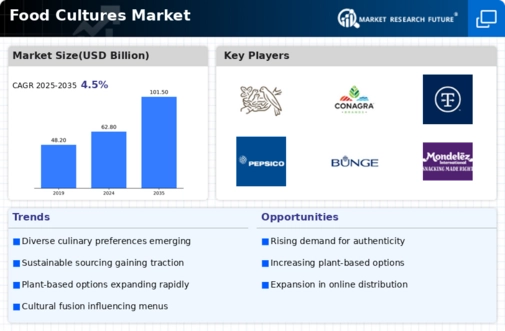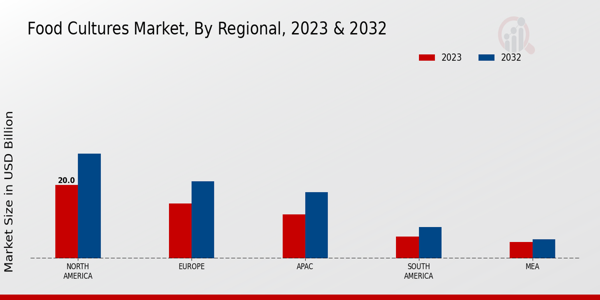Market Growth Projections
The Global Food Cultures Market Industry is projected to experience substantial growth in the coming years. With a market value of 62.8 USD Billion in 2024, the industry is expected to expand significantly, reaching an estimated 101.5 USD Billion by 2035. This growth trajectory indicates a robust compound annual growth rate (CAGR) of 4.47% from 2025 to 2035. Such projections reflect the increasing consumer interest in diverse culinary experiences and the ongoing globalization of food cultures. As the market evolves, it is likely to witness innovations and shifts in consumer preferences, further driving its expansion.
Health and Wellness Trends
The increasing focus on health and wellness significantly shapes the Global Food Cultures Market Industry. Consumers are becoming more health-conscious, seeking foods that promote well-being and nutritional benefits. This shift is evident in the rising popularity of plant-based diets, organic foods, and functional ingredients. For example, the demand for superfoods, such as quinoa and chia seeds, has surged as consumers seek to enhance their diets with nutrient-dense options. This trend aligns with the broader market growth, as the industry is expected to reach 101.5 USD Billion by 2035, driven by a collective desire for healthier eating habits.
Consumer Demand for Authenticity
The quest for authenticity is a driving force in the Global Food Cultures Market Industry. Consumers increasingly seek genuine culinary experiences that reflect traditional practices and local ingredients. This trend is particularly pronounced in the rise of artisanal food products and farm-to-table dining experiences. Restaurants that emphasize locally sourced ingredients and traditional cooking methods often attract consumers looking for unique and authentic meals. This demand for authenticity not only enhances consumer satisfaction but also supports local economies and food producers. As a result, the market is poised for growth, reflecting a broader appreciation for diverse food cultures.
Cultural Diversity and Globalization
The Global Food Cultures Market Industry is profoundly influenced by cultural diversity and globalization. As societies become more interconnected, the exchange of culinary practices and ingredients flourishes. This trend is evident in urban areas where multicultural populations introduce traditional dishes from their homelands, enhancing local food offerings. For instance, cities like New York and London showcase a plethora of international cuisines, reflecting the diverse backgrounds of their residents. This cultural amalgamation not only enriches the culinary landscape but also drives consumer interest in authentic global flavors, contributing to the projected market value of 62.8 USD Billion in 2024.
Sustainability and Ethical Consumption
Sustainability and ethical consumption are emerging as critical drivers in the Global Food Cultures Market Industry. Consumers are becoming more aware of the environmental and social impacts of their food choices, leading to a preference for sustainable and ethically sourced products. This trend is evident in the increasing demand for organic foods, fair-trade products, and environmentally friendly packaging. For instance, many consumers now prioritize brands that demonstrate a commitment to sustainability, influencing purchasing decisions. This shift towards responsible consumption is likely to shape the market landscape, as businesses adapt to meet the evolving expectations of conscientious consumers.
Technological Advancements in Food Production
Technological advancements play a pivotal role in the Global Food Cultures Market Industry, enhancing food production and distribution processes. Innovations such as precision agriculture, vertical farming, and food preservation technologies are transforming how food is produced and consumed. These advancements not only improve efficiency but also contribute to sustainability by reducing waste and resource consumption. For instance, vertical farms in urban areas allow for the cultivation of fresh produce year-round, catering to the growing demand for local and organic foods. As these technologies proliferate, they are likely to support the market's growth trajectory, with a projected CAGR of 4.47% from 2025 to 2035.























